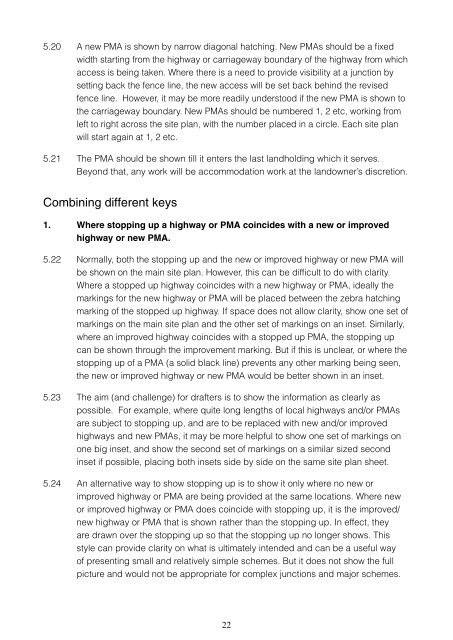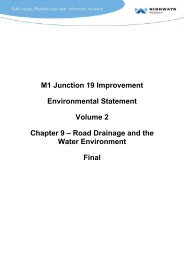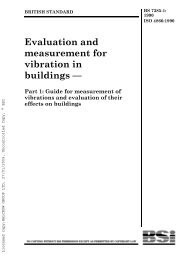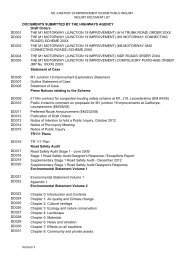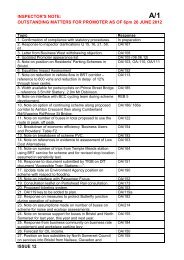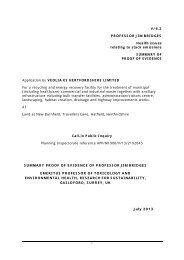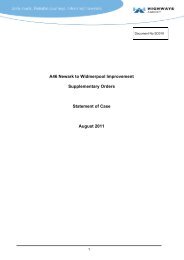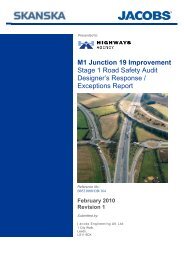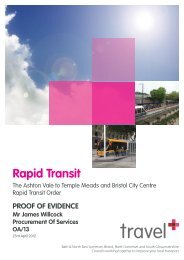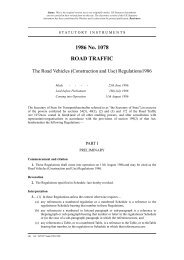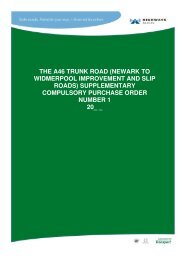Highways Act Orders and Schemes
Highways Act Orders and Schemes
Highways Act Orders and Schemes
You also want an ePaper? Increase the reach of your titles
YUMPU automatically turns print PDFs into web optimized ePapers that Google loves.
5.20 A new PMA is shown by narrow diagonal hatching. New PMAs should be a fixed<br />
width starting from the highway or carriageway boundary of the highway from which<br />
access is being taken. Where there is a need to provide visibility at a junction by<br />
setting back the fence line, the new access will be set back behind the revised<br />
fence line. However, it may be more readily understood if the new PMA is shown to<br />
the carriageway boundary. New PMAs should be numbered 1, 2 etc, working from<br />
left to right across the site plan, with the number placed in a circle. Each site plan<br />
will start again at 1, 2 etc.<br />
5.21 The PMA should be shown till it enters the last l<strong>and</strong>holding which it serves.<br />
Beyond that, any work will be accommodation work at the l<strong>and</strong>owner’s discretion.<br />
Combining different keys<br />
1. Where stopping up a highway or PMA coincides with a new or improved<br />
highway or new PMA.<br />
5.22 Normally, both the stopping up <strong>and</strong> the new or improved highway or new PMA will<br />
be shown on the main site plan. However, this can be difficult to do with clarity.<br />
Where a stopped up highway coincides with a new highway or PMA, ideally the<br />
markings for the new highway or PMA will be placed between the zebra hatching<br />
marking of the stopped up highway. If space does not allow clarity, show one set of<br />
markings on the main site plan <strong>and</strong> the other set of markings on an inset. Similarly,<br />
where an improved highway coincides with a stopped up PMA, the stopping up<br />
can be shown through the improvement marking. But if this is unclear, or where the<br />
stopping up of a PMA (a solid black line) prevents any other marking being seen,<br />
the new or improved highway or new PMA would be better shown in an inset.<br />
5.23 The aim (<strong>and</strong> challenge) for drafters is to show the information as clearly as<br />
possible. For example, where quite long lengths of local highways <strong>and</strong>/or PMAs<br />
are subject to stopping up, <strong>and</strong> are to be replaced with new <strong>and</strong>/or improved<br />
highways <strong>and</strong> new PMAs, it may be more helpful to show one set of markings on<br />
one big inset, <strong>and</strong> show the second set of markings on a similar sized second<br />
inset if possible, placing both insets side by side on the same site plan sheet.<br />
5.24 An alternative way to show stopping up is to show it only where no new or<br />
improved highway or PMA are being provided at the same locations. Where new<br />
or improved highway or PMA does coincide with stopping up, it is the improved/<br />
new highway or PMA that is shown rather than the stopping up. In effect, they<br />
are drawn over the stopping up so that the stopping up no longer shows. This<br />
style can provide clarity on what is ultimately intended <strong>and</strong> can be a useful way<br />
of presenting small <strong>and</strong> relatively simple schemes. But it does not show the full<br />
picture <strong>and</strong> would not be appropriate for complex junctions <strong>and</strong> major schemes.<br />
22


